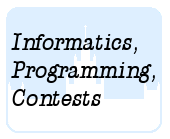 Лето 2
Лето 2
 B. Do the Untwist
B. Do the Untwist
 Техника программирования, моделирование
Техника программирования, моделированиеОлимпиадные задачи на английском языке

| 02/07/2007 | Лето 2007 дорешивание ( 2B) |
| 04/07/2007 | Лето 2007 - 2 (B) |
Ограничения: время – 1s/2s, память – 2MiB Ввод: input.txt или стандартный ввод Вывод: output.txt или стандартный вывод 
Послать решение Blockly Посылки Темы Где Обсудить (0)
Cryptography deals with methods of secret communication that transform a message (the plaintext) into a disguised form (the ciphertext) so that no one seeing the ciphertext will be able to figure out the plaintext except the intended recipient. Transforming the plaintext to the ciphertext is encryption; transforming the ciphertext to the plaintext is decryption. Twisting is a simple encryption method that requires that the sender and recipient both agree on a secret key `k`, which is a positive integer.
The twisting method uses four arrays: plaintext and ciphertext are arrays of characters, and plaincode and ciphercode are arrays of integers. All arrays are of length `n`, where `n` is the length of the message to be encrypted. Arrays are origin zero, so the elements are numbered from 0 to `n-1`. For this problem all messages will contain only lowercase letters, the period, and the underscore (representing a space).
The message to be encrypted is stored in plaintext. Given a key `k`, the encryption method works as follows. First convert the letters in plaintext to integer codes in plaincode according to the following rule: ' ' = 0, 'a' = 1, 'b' = 2, …, 'z' = 26, and '.' = 27. Next, convert each code in plaincode to an encrypted code in ciphercode according to the following formula: for all `i` from 0 to `n-1`,
ciphercode[`i`] = (plaincode[`"ki"` mod `n`] – `i`) mod 28.
(Here x mod y is the positive remainder when x is divided by y. For example, 3 mod 7 = 3, 22 mod 8 = 6, and –1 mod 28 = 27. You can use the C '%' operator or Pascal 'mod' operator to compute this as long as you add y if the result is negative.) Finally, convert the codes in ciphercode back to letters in ciphertext according to the rule listed above. The final twisted message is in ciphertext. Twisting the message cat using the key 5 yields the following:
| Array | 0 | 1 | 2 |
| plaintext | 'c' | 'a' | 't' |
| plaincode | 3 | 1 | 20 |
| ciphercode | 3 | 19 | 27 |
| ciphertext | 'c' | 's' | '.' |
Your task is to write a program that can untwist messages, i.e., convert the ciphertext back to the original plaintext given the key `k`. For example, given the key 5 and ciphertext 'cs.', your program must output the plaintext 'cat'.
The input file contains one or more test cases, followed by a line containing only the number 0 that signals the end of the file. Each test case is on a line by itself and consists of the key k, a space, and then a twisted message containing at least one and at most 70 characters. The key `k` will be a positive integer not greater than 300. For each test case, output the untwisted message on a line by itself.
Note: you can assume that untwisting a message always yields a unique result. (For those of you with some knowledge of basic number theory or abstract algebra, this will be the case provided that the greatest common divisor of the key `k` and length `n` is 1, which it will be for all test cases.)
Example input
5 cs. 101 thqqxw.lui.qswer 3 b_ylxmhzjsys.virpbkr 0
Example output
cat this_is_a_secret beware._dogs_barking

 Начало
Начало